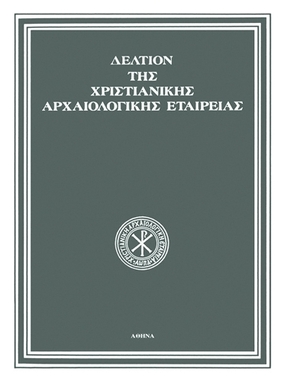Παρατηρήσεις στην οικοδομική ιστορία της μονής Σαγματά στη Βοιωτία
Part of : Δελτίον της Χριστιανικής Αρχαιολογικής Εταιρείας ; Vol.36, 1995, pages 49-70
Issue:
Pages:
49-70
Parallel Title:
Observations on the Structural History of Sagmata Monastery in Boiotia
Section Title:
Articles
Author:
Abstract:
The katholikon of the Sagmata monastery was publishedby A. K. Orlandos in his Archive of the Byzantine Monuments of Greece, and his conclusions were adopted bylater scholars without being closely scrutinised. Thecompilation of a study for the church's restoration togetherwith evidence that came to light in works on the cellsenabled a re-examination of the structural history of thisimportant monument of southern Greece.The church is of the complex four-column, domed, crossin-square type with a spacious lete and exonarthex. Thedome of the nave of the katholikon collapsed in anearthquake in 1914 and was replaced at an unknown dateby the present makeshift wooden pitched roof. Fortunately, however, a photograph of the church prior to thedestruction of the dome is preserved in the monastery.This and dimensions from the monument itself facilitatedthe dome's graphic reconstruction (Figs 9-13). The domebears a striking resemblance to that of the church ofHagios Nikolaos at Kampia, a nearby monument of aboutthe same date as the Sagmata monastery. Orlandos' graphicreconstruction differs from that presented here.Orlandos dated the church to the second half of the 12thcentury. He also dated the exonarthex to the 15th-16thcentury. In his opinion, the 1675 renovations involvedthe construction of the bell-tower on the west side, thearched frames of the narthex doors and the lete, thedevelopment of the west conch, and the inclusion ofsculptural members in the church's walls. Megawattempted to date the church even more precisely to thelast quarter of the 12th century.The new evidence provided from the restoration studytogether with a perusal of the Life of Hosios Clement havemodified these conclusions on the monument's structuralhistory. The following building phases were noted:a) The beginning of the 12th century (1105-06). Themonastery was founded by Hosios Clement (d. 1111),who retired there himself after having been defeated inthe struggle for succession after the death of HosiosMeletios, founder of the monastery of the same name.The first phase of the katholikon, of which remains existin the lower part of the main nave and the lete, date to thisperiod. Dating was based on the existence of structuralcrosses in the masonry as well as the type of openingsbelonging to this phase. A powerful argument in favourof this date is the chrysobul of the emperor Alexios IKomnenos which -albeit a forgery- mentions the date1 106, thus according with other sources.b) The second half of the 12th century (possibly immediately following the withdrawal of the Normans in1147). This involved the enlargement of the church withthe construction of the superstructure over the nave andthe lete and the addition of a exonarthex. This dating wasestablished on the grounds of the integral structuraltexture of the exonarthex and the superstructure of thenave and lete, along with common formal characteristics:i) the absence of a large number of brick decorativemotifs; ii) the use -instead of bricks- of carved porosblocks for the openings and cornices, a common feature inthe late 12th century; iii) the association of the extantbrick decoration with that on other securely dated monuments; iv) two ornamental crosses, framed with bricks,symmetrically included in either side of the west entranceto the church, and v) the limited use of dog-tooth fretsaround the openings. All the above point to a later 12thcentury date for the monument.c) 1675. According to a founder inscription in the conchabove the west door of the exo-narthex, wide scalerepairs were undertaken, possibly including the erectionof the bell-tower, the heightening of the drum of thedome and additions to the roof of the sanctuary.d) 1914. An earthquake results in the collapse of thedome of the nave and the exterior edge of the north wall.These were replaced with the presented pitched tile roof.e) 1976-77. Work undertaken by the ArchaeologicalService. Demolition of the additions over the roof of thesanctuary and restoration of the original form.The cell to the west of the katholikon is dated to the 12thcentury due to its exterior brick decoration. This mayhave been the cell of the Saint himself which became anobject of veneration after this death. Finally, ribbedvaults in the monastery's cells can be dated to the sameperiod as the katholikon.
Subject:
Subject (LC):




